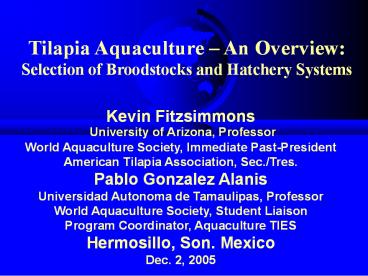Tilapia Aquaculture - PowerPoint PPT Presentation
Title:
Tilapia Aquaculture
Description:
Tilapia Aquaculture An Overview: Selection of Broodstocks and Hatchery Systems ... Brackish water Red hybrid strains. Pond systems O. niloticus or red strains ... – PowerPoint PPT presentation
Number of Views:900
Avg rating:3.0/5.0
Title: Tilapia Aquaculture
1
Tilapia Aquaculture An Overview Selection of
Broodstocks and Hatchery Systems
- Kevin Fitzsimmons University of Arizona,
Professor - World Aquaculture Society, Immediate
Past-President - American Tilapia Association, Sec./Tres.
- Pablo Gonzalez Alanis
- Universidad Autonoma de Tamaulipas, Professor
- World Aquaculture Society, Student Liaison
- Program Coordinator, Aquaculture TIES
- Hermosillo, Son. Mexico
- Dec. 2, 2005
2
Tilapia breeds
- Proper selection of fish for your type of
production system is second most important
decision (after marketing) - There are several species, hybrid strains, and
breeding programs available - Goals are fast growth, good FCR and mostly male
fish - Must determine if farm will buy fry or
fingerlings or attempt to maintain own hatchery
3
Tilapia species and breeds
- O. niloticus (Nile Tilapia) Most commonly used
tilapia 70-75 of global production - O. aureus (Blue Tilapia) about 5 of global
production - O. mossambicus - (Mossambique or Java Tilapia)
about 5 of global production - Red hybrid strains - O. mossambicus and/or O.
urolepis-hornorum (Wami River Tilapia) crossed
with O. aureus and/or O. niloticus) about 20 of
global production
4
Tilapia species and breeds
- Match fish to production system
- Brackish water Red hybrid strains
- Pond systems O. niloticus or red strains
- Cage systems O. niloticus or red strains
- Intensive (tanks, raceways or recirculating
systems) - O. niloticus or red strains - Cooler temperatures O. aureus or hybrids
- South Africa and California (only O. mossambicus
and hybrids)
5
Genetic Improvements in Tilapia
(From Mair, G., 2002)
6
O. niloticus strains and breeding programs
- G.I.F.T. - Genetically Improved Farmed Tilapia
- Chitralada From a strain kept at the Chitralada
Royal Palace in Thailand - Genomar A Norwegian-Brazilian breeding program
- G.I.F.T.-EXCEL Additional breeding program
continued in the Philippines - At least 3 more family selection programs
7
Red Tilapia strains
- Red O. mossambicus mutants found in 1970s
- Backcrossings fixed the mutation
- Taiwan, Florida, Israeli, and Stirling (Scotland)
strains were developed - These were repeatedly out-crossed to other
species (New strains in Jamaica, Arizona,
Colombia, Ecuador, Thailand, China, Vietnam) - Many red strains now available, most with high
salinity tolerance
8
Methyltestosterone technique
- Feed fry with food containing MT (60mg 17a-MT/kg
of feed) for 21 days - For product to be sold in US, MT feed should be
purchased from approved supplier - Females develop as males, males unaffected
- Isotope labeling studies demonstrate that MT in
fish is below detectable limits 30 days after
last feeding - 90 develop as male fish
9
YY technique
- Treat fry with estrogen
- Males develop as females
- These XY females are mated to normal males (XY)
- ¼ XX ½ XY ¼ YY
- XY and YY males are progeny tested to XX
- Fathers of all male fry (XY) must be YY
- YY males can be sold and crossed to normal
females (XX) to get almost all male progeny (XY)
10
The YY male technology
(GMT)
(From Mair, G., 2002)
11
YY technique
- FishGen, is a UK based company which sells YY
males and fry from YY male hatcheries in several
countries - Genetically Male Tilapia (GMT) is their brand
name - Food fish are two generations removed from being
treated with hormone and can be considered
organic. - Technique could be copied, but hatchery would
need several years and many qualified biologists
to develop a program
12
Hybrid crosses
- Several inter-specific crosses yield high
proportion of males (70-90) - Requires maintenance of two pure species breeding
lines - This technique was developed in Israel and
Chinese claim to do this with GIFT niloticus
crossed with O. aureus. However, use of MT is
suspected.
13
Hatchery styles
- Normally stock 1? and 3?
- Eggs are incubated by female
- Eggs can be collected and hatched in jars or
trays - Or hatched by mother and fry collected when free
swimming
14
Dr. Raul Ponzoni and World Fish Center program in
Malaysia .
15
Typical spawning or fry rearing hapas
16
Pond spawning vs. tank spawning
- Pond or hapa rearing for large numbers
- Tank spawning for small numbers and directed
rearing programs
17
Jar and trayegg hatching
- Jar hatching better for large numbers with little
supervision - Tray hatching better if labor is abundant and
high survival is important
18
Technologies to reduce externalities(MT use and
discharge)
- Reduce or eliminate MT use (mixed sex, cages, YY,
hybrids, salt-water culture) - Use phytochemicals to induce sex change (still
experimental) - Remove effluent MT with carbon, UV, or ozone
19
Post hatch
- Swim-up fry allowed to leave hatching vessel
- Usually collected in screened buckets or trays
- Start sex reversal or start normal feeding in
hapas
20
Fry moved to pre-growout around 1 g































